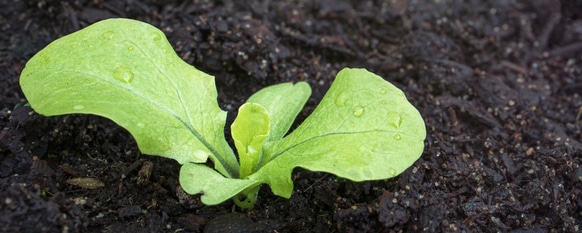Growing your own produce results in herbs, fruits, and veggies that taste far better — and are better for you, nutritionally — than anything available at the supermarket. Lettuce is a fantastic example of this! Homegrown lettuce tastes sweeter and fresher than store-bought and contains more nutrients such as vitamin A.
If you’re continually buying those pesky plastic containers of your favorite leafy green, you should try your hand at growing lettuce at home.
Make sure to also check out our article on proper care for hickory trees to make sure that any hickory trees on your property continue to flourish.
Lettuce is a garden favorite because of it’s easy growing nature, cold tolerance, and ability to grow tucked inconspicuously between other plants or in containers. Plants are considered hardy and grow quickly, with some types ready to pick in as little as four weeks.
Choose your favorite variety or varieties, and with some planning, you can harvest fresh iceberg, looseleaf, romaine, or butterhead through the spring and fall. Fresh leafy greens right at your fingertips any time lunch or dinner calls for a salad or a sandwich.

General Information
Lettuce (Lactuca sativa) is popular with new and experienced gardeners alike since it is a great all-around vegetable. Plants grow quickly, are ready for harvest within a short time frame compared to other vegetables, and produce for a long time. Overall they are low maintenance, and they also grow well in raised beds or containers.
Popular Cultivars
Most people are familiar with lettuce’s four basic types, differentiated by their varied head shape and leaf formation: Crisphead, Romaine, loose-leaf, and Butterhead. These cultivar groups are the most commonly grown, but hundreds of different varieties are found within these groups. The varieties differ in qualities like leaf color, taste, and shelf life.
- Crisphead lettuce, commonly known as Iceberg, forms tight dense heads that resemble cabbage. They are known for their crunchy texture and mild flavor.
- Romaine, or Cos, forms heads with elongated leaves, each with a pronounced rib down the center. This variety has a more bitter flavor.
- Loose-leaf does not form heads and has tender, delicate leaves with a mild flavor.
- Butterhead forms loosely packed heads, and its leaves have a buttery texture.

Timing
Lettuce is classified as a cool-season crop and grows well in most USDA growing zones (4, 5, 6, 7, 8, 9) during the spring and fall when temperatures are between 45 and 80°F. Seeds can be direct sown after soil temperatures reach 40°F (4°C), though they germinate best between 55 and 65°F (13 to 18°C).
- Start lettuce seeds indoors four weeks before the last frost date for the area; transplant lettuce into the garden as soon as the soil is workable.
- Direct sow seeds in the spring around the time of the last frost, once soil temperatures are high enough.
- Plant fall lettuce about 4 to 8 weeks before the first autumn frost.
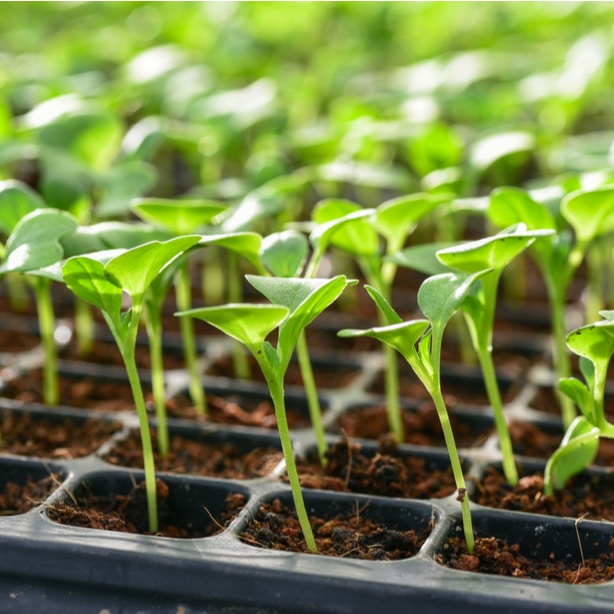
Soil Preparation
Since lettuce seeds are small, it’s essential to create a well-tilled seedbed before planting. Large clods of dirt, hardpans, and stone inhibit germination or impede plant growth. Dig down to a depth of 12 inches, working the soil well. While working the soil, incorporate 2 inches of organic matter such as finished compost or well-aged manure.
Planting
Lettuce seeds are small and need light for germination, so plant them just below the soil surface. Sow all varieties ⅛ to ¼” deep and space rows 12 to 18 inches apart. When plants have 3 to 4 true leaves, thin loose-leaf to 4-inches apart, Romaine and Butterhead 6 to 8 inches, and Crisphead to 16-inches.
Care Guide
Lettuce is considered easy to grow by most gardeners. If you want to get the best harvest possible, plants need proper care to meet their basic needs. Regardless of the variety grown, lettuce prefers full sun, consistent soil moisture, regular doses of dilute fertilizer, and to be kept free from pesky weeds and bothersome pests.
Sunlight
Similar to most garden veggies, lettuce grows best in a “full sun” spot in the garden where it receives at least 6 hours of direct sun daily, preferably receiving some shade during the hottest part of the afternoon. The partial shade keeps the plant cooler, preventing it from bolting and becoming bitter. Lettuce will tolerate partial shade.
Watering
Keeping plants well-watered produces tender lettuce leaves. Water whenever the top inch of soil dries out, keeping a close eye on soil moisture on hot, windy days. In many cases, plants need water 2 to 3 times a week. Avoid overhead watering, instead wet the soil surrounding plants to prevent excess moisture on the leaves.
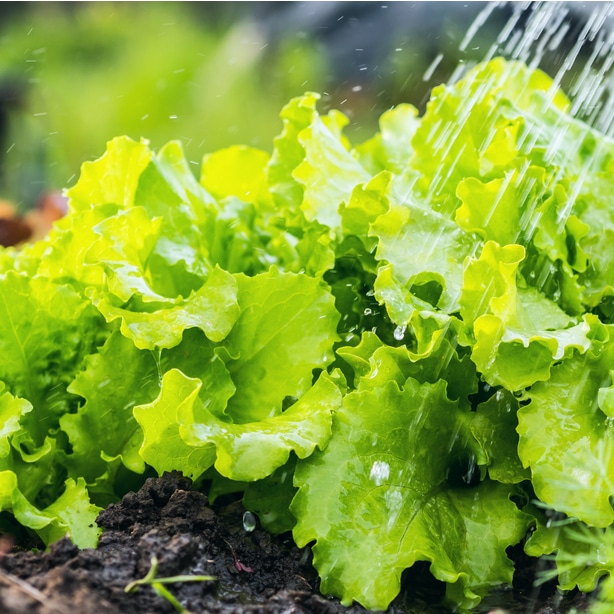
Make sure to also check out our guide on growing rosemary here on the Green Pinky for a fun, aromatic herb to grow.
Fertilizer Requirements
Since lettuces are known as a “cut and come again” crop, they continuously need plenty of fertilizer to produce the next harvest of leaves. Once seedlings emerge, start fertilizing them every two weeks using a balanced, water-soluble fertilizer such as 10-10-10 or 5-5-5, diluted to half of the rate listed on the product label.
Weeding
Lettuce has a short root system because of its quick-growing nature, making it very susceptible to competition from weeds. This shallow root system is easily disturbed by mechanical weeding, which results in a reduction in growth and yield. When weeds sprout up in the garden bed, remove them by hand when they are still small.
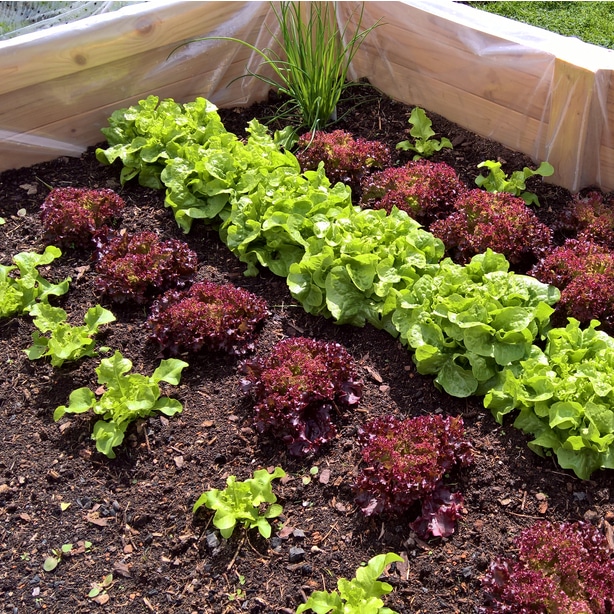
Pest Management
Dealing with pests is essential when growing lettuce. Aphids, slugs, deer, and rabbits especially enjoy the tender leaves, probably as much as the gardeners themselves. With lettuce leaves so close to the ground, they are an easy target. This makes it crucial to continually watch for pests and treat them immediately if seen.
Aphids are a common plant pest in gardens. The tiny, pear-shaped, light-colored insects suck sap from the foliage, causing leaves to appear distorted and drop. Aphids also secrete a substance known as honeydew, which increases the chances of sooty mold growth. One of the best ways to control them is by spraying plants with a dilute water and dish soap solution.
Slugs are attracted to dark, damp spaces with ample green foliage to much on. As leaves grow larger and shade the soil, keep a close watch for this pest. The best control method is tediously picking slugs from the soil and plants a couple of hours after sunset. To prevent them from bothering your lettuce, spread diatomaceous earth or boric acid granules around plants’ base as a barrier.
Keeping deer and rabbits out of the garden isn’t an easy feat, and tender leafy lettuce is one of the first plants they’ll eat. The best control method is to cover lettuce with protective barriers such as shade cloth, chicken wire, or floating row covers.

Growing Tips
As mentioned above, growing lettuce is pretty straightforward and one of the easiest garden vegetables to grow. Like all plants, over time, gardeners have discovered some tips and tricks for growing lettuce. These handy suggestions improve yields or prevent plants from succumbing to heat and pests, increasing the lettuce’s harvestable amount.
- After direct sowing seeds, plant more seeds every two weeks for a continuous crop.
- As temperatures climb and days lengthen, cover plants with shade cloth to prevent bolting. Shade cloth keeps temperatures cooler but allows filtered light to reach the plants.
- To control aphids, plant rows of chives or garlic between your lettuces. These aromatic plants naturally repel insects, acting as “barrier plants.”
- Spread a layer of clean sand around the base of lettuce plants, preventing the leaves from touching the damp soil, preventing lettuce rot.
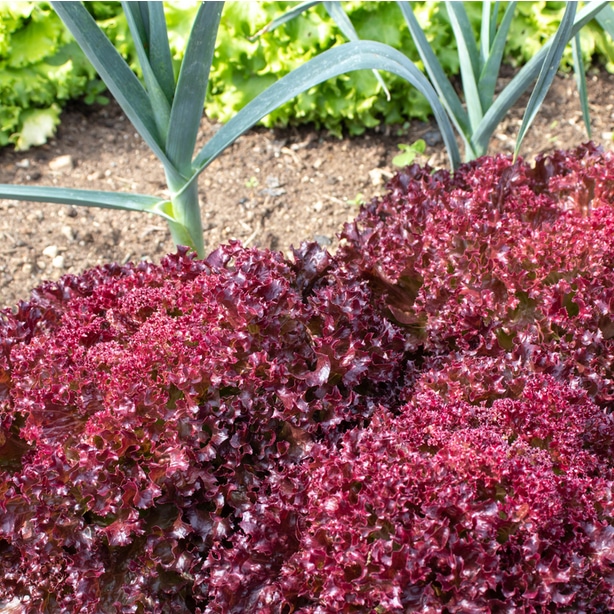
Companion Plants
Lettuce grows really well close to many other plants in the garden, including vegetables, herbs, and even some common flowers. It pairs best with taller plants that provide shade to reduce bolting, root crops, aromatic plants/herbs, and anything that acts as a natural repellant or purposely attracts pests away from the lettuce itself.
Some of the best companion plants for lettuce include:
- Asparagus
- Beets
- Calendula
- Carrots
- Chervil
- Chives
- Cilantro
- Garlic
- Marigolds
- Mint
- Nasturtiums
- Onions
- Parsnips
- Peas
- Radishes
- Strawberries
- Turnips
Avoid growing lettuce next to fennel or plants in the cabbage family; both inhibit seed germination or plant growth.

